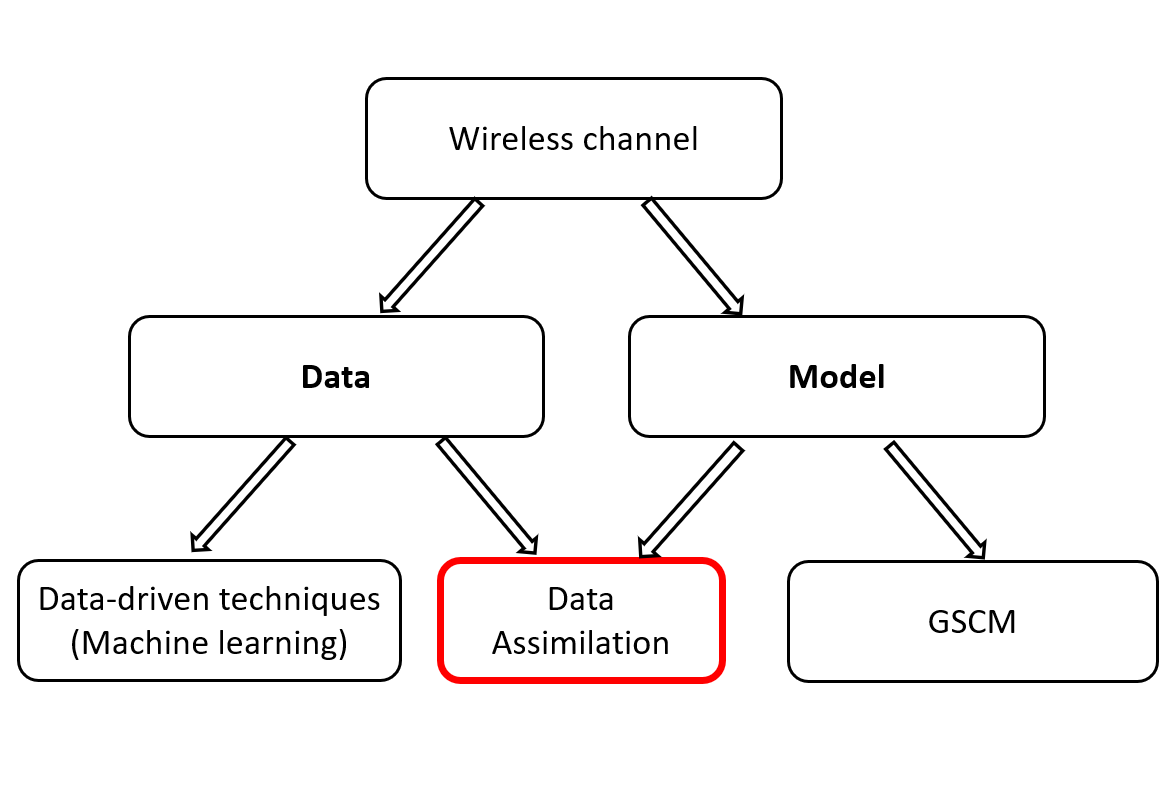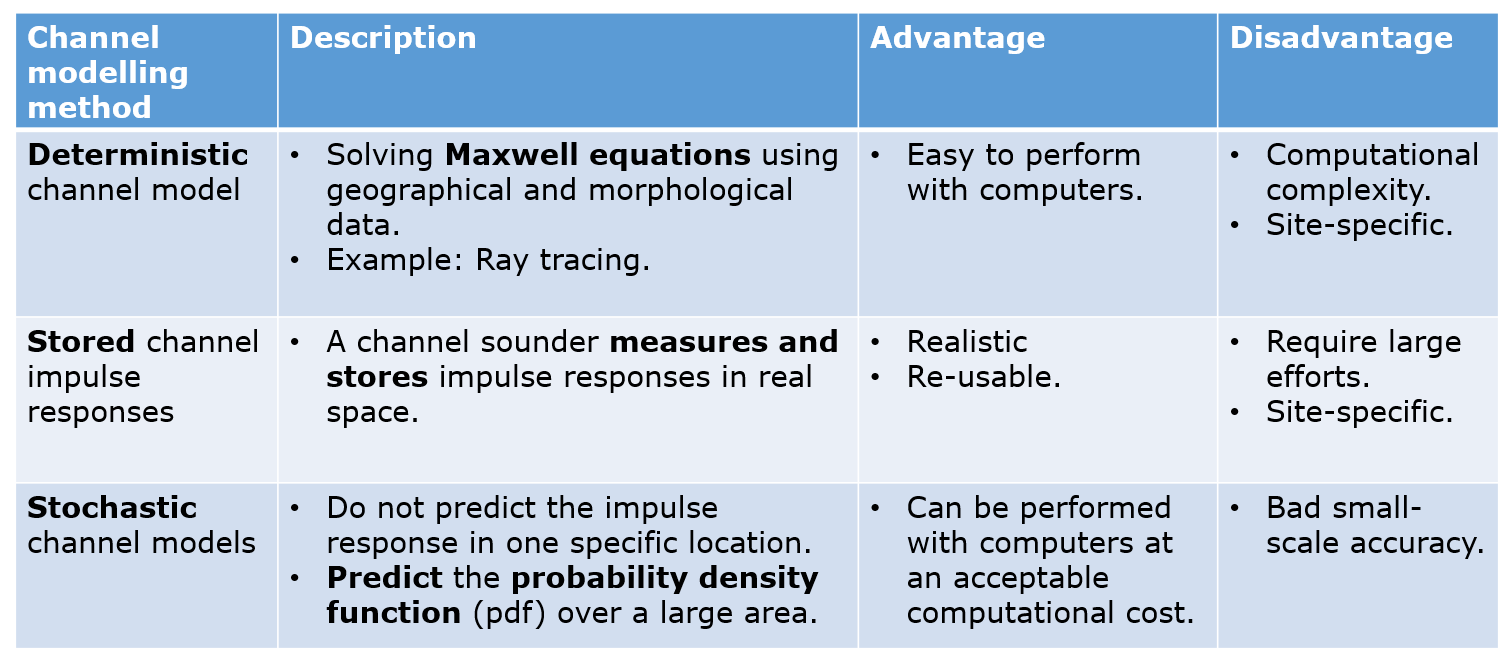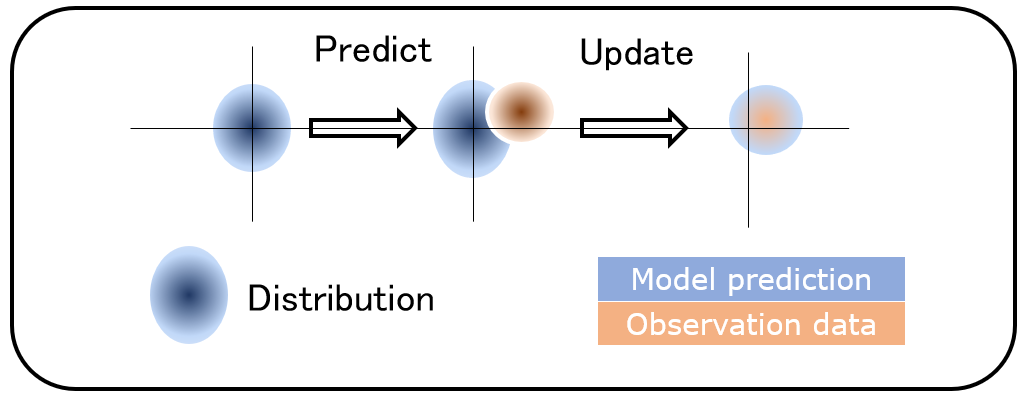Stochastic wireless channel model, data assimilation, data science, and machine learning.

Tags:
wireless statistics datascienceDescription:
A way how wireless communication is related to data science and AI.
Stochastic wireless channel models
Mobile channel describes linear and non-linear systems in which the input signal is applied into and produce the output signal. In the general sense in the field of wireless communication, the input here is the signal fed to the transmitter (Tx) and the output is the signal received at the receiver (Rx).
A channel model is a theoretical model that describes the channel. For the design, simulation, and planning of wireless systems, we need models for the propagation channels. There are three main types of these channel models, according to [1, ch. 7.1]

In reality, at large scales, the stochastic model is often preferred since it is usually too complicated to describe all reflection, diffraction, and scattering processes that determine the channel. Rather, it is preferable to describe the probability that a channel parameter attains a certain value [1, ch. 5.1]. More details about how we can do that could be found in the previously mentioned reference.
Indeed, a type of stochastic channel model, called GSCM (Geometry-based Stochastic Channel Model) is recommended by 3GPP, the standardization body of cellular networks all over the world, to be used for channel modelling in the real life cellular networks.
Because wireless channels now are described by stochastic models, naturally, theories of statistics could be applied to the problems of wireless channel models. And as you may guess, where statistics exists, Data Science and its branches come along.
Data Assimilation comes into play
Data Assimilation is a branch of Data Science, where scientists try to combine the prediction from numerical models with results from measurements in order to acquire a meaningful result.
For example, knowing the initial location, velocity and constant acceleration of a car, we can estimate the its location by using a numerical model of moving object with a constant acceleration. However, since all the parameters used for the model has errors, the final estimation will inherently have certain errors, govern by a probability density function (pdf). On the other hand, if we read the distance traveled by the car on its odometer, we will get another result showing how far the car has traveled, but unfortunately, this observation result too has errors governed by another pdf due to the inaccuracy of the odometer. The problem will be deciding whether to trust the model, or to trust the observation, or to trust both. This is where the techniques of Data Assimilation come in to fuse those two aforementioned pdf into another pdf that best describes the system.

Data assimilation combines observations and models in a way that accounts for the uncertainties in each, while simultaneously respecting certain constraints. These include the laws of motion of the system through the model equations, and how the measurements physically relate to the system’s variables. In weather forecasting, recent weather observations are combined with today’s model forecast to obtain a complete picture of the atmosphere now in order to start a new forecast for the days ahead. Data assimilation is often thought of as a way of keeping a model ‘on the tracks’ by constantly correcting it with fresh observations.
-- University of Reading
Return to the topic of Wireless communication, using the stochastic wireless channel models, we can roughly estimate a model that produces prediction data. However, this prediction will certainly contain a lot of errors due to the uncertainties in the model construction. This is where Data Assimilation could be applied to use measurement data to correct, or to minimize the errors of the model. With enough measurement data, a wireless channel model that well describe a geolocation area could be achieved.
Possibilities of other novel Data Science methods
With the unprecedented raise of Artificial Intelligence (AI) and Machine Learning (ML) recently, a natural question you may ask is since we have measurement data, why do we not just feed the data into some machine learning models in order to calculate the channel response, instead of relying on some hard-to-understand stochastic models? Yes, that is indeed a very good question.
Drawbacks of Data-driven techniques
Using data-driven techniques like AI/ML without a physical model often results in the usage of deep learning and other types of unexplainable AI. While the technology is promising, this implementation still faces several major drawbacks:
- Insufficient data: According to the GIGO principle, any AI is only as good as the data it is fed to. In the field of wireless communication, doing measurements is expensive, as a result, there are not that many data points for the AI to be trained on. Furthermore, measurement data often contains a lot of noise and outliers that requires intensive data cleaning before they become useful.
- The need of an explainable ML model: for the purpose of testing wireless channels, engineers should be able to understand how the model gives its final result. In traditional approaches using physical models, this could easily be done. However, using unexplainable models like deep learning, it is very hard to explain why the AI behaves that way, in order to make sufficient fixes and decisions for the wireless channels.
How Data-driven techniques could be useful
As mentioned, using data-driven techniques like AI/ML without a physical model often results in unexplainable AI, which is not good due to reasons above. However, if done right, we can construct explainable AI to assist the data assimilation processes. The problem is, explainable AI models that work are not so different from existing Data Assimilation techniques.
From a data assimilation perspective, ML/DL does not introduce completely new or revolutionary ideas. As we have shown here, ML/DL techniques have much in common with the standard workflow of variational data assimilation, though these similarities tend to be partly obfuscated by the different nomenclature used in the two fields.
...
However, for reasons discussed in e.g. Bonavita & Laloyaux (2020) [2], while it is clear that these tools can be useful complements and additions to our physics-based models, it would be naïve to believe that they can replace them entirely.
-- ECMWF [3]
Although fully utilize AI/ML in the problems of wireless channel model is hard for now due to reasons revolving data, with the accelerating rate of data creation nowadays, it is totally possible that some day in the near future, when the quantity and quality of data is sufficient, we can apply data-driven ML methods to solve the problem of wireless channels.
References:
- [1] A. F. Molisch, “Wireless Communications,” in 2nd ed. John Wiley & Sons Ltd., 2011.
- [2] Laloyaux, P., and M. Bonavita, 2020: Improving the handling of model bias in data assimilation. ECMWF Newsletter No. 163.
- [3] Massimo Bonavita, Alan Geer, Patrick Laloyaux, Sébastien Massart, and Marcin Chrust, 2021: Data assimilation or machine learning? ECMWF Newsletter No. 167
